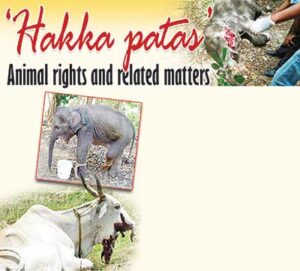
Sri Lanka to meet its current and future electricity demand by use of renewable energy by 2050

Sri Lanka would be able to meet its current and future electricity demand by use of renewable energy by 2050, according to a joint study by the UN Development Programme and Asian Development Bank, the Public Finance Report International reported.
The report, titled Assessment of Sri Lanka’s Power Sector—100 percent Electricity Generation through Renewable Energy by 2050, noted that by then Sri Lanka’s installed electricity generation capacity needs would increase from the current 3,700mw to about 34,000mw.
Of this, 15,000mw would be wind energy and about 16,000mw solar. The remainder is expected to be met from hydroelectric and biomass power plants.
The study also identified a need to ensure stability of the electricity grid by introducing electricity storage capable of the instantaneous provision of 3,600mw and energy storage capacity of 15,000mw hours.
A long-term switch from fossil to renewable fuels would reduce Sri Lanka’s fuel import bill by about $18bn cumulatively but found the country would need investment of $50bn.
Priyantha Wijayatunga, director in the ADB’s South Asia energy division, said: “ADB has expressed its continuous support to low-carbon development of Sri Lanka.
“Recent proposals including a rooftop solar programme and a large-scale wind power project demonstrate ADB’s commitment in this regard. This assessment report can serve as a comprehensive example for future utilities globally on how decentralised clean energy services can be governed.”
Source – 22/08/2017, Tomes Online, See more at – http://www.sundaytimes.lk/article/1029967/sri-lanka-to-meet-its-current-and-future-electricity-demand-by-use-of-renewable-energy-by-2050

Cost of natural disasters and climate change taking a heavy toll on Sri Lanka

This year, yet again, flooding caused by heavy monsoon rains came and receded. Meanwhile, this year alone, more than one million people have been hard hit by the worst drought in 40 years.
The following report was first published on the World Bank Blog
The media, with few exceptions, have moved on to other topics and a sense of calm pervades.
We are in the eye of the storm — that misleading lull before mother nature unleashes her fury once again.
In Sri Lanka alone, costs from natural disasters, losses from damage to housing, infrastructure, agriculture, and from relief are estimated at LKR 50 billion (approx. USD 327 million). The highest annual expected losses are from floods (LKR 32 billion), cyclones or high winds (LKR 11 billion), droughts (LKR 5.2 billion) and landslides (LKR 1.8 billion). This is equivalent to 0.4 percent of GDP or 2.1 percent of government expenditure. (#SLDU2017). Floods and landslides in May 2016 caused damages amounting to US$572 million.
These numbers do not paint the full picture of impact for those most affected, who lost loved ones, irreplaceable belongings, or livestock and more so for those who are back to square one on the socio-economic ladder.
Even more alarming, these numbers are likely to rise as droughts and floods triggered by climate change will become more frequent and severe. And the brief respite in between will only get shorter, leaving less time to prepare for the hard days to come.
Therefore, better planning is even more necessary. Sri Lanka, like many other countries has started to invest in data that highlights areas at risk, and early warning systems to ensure that people move to safer locations with speed and effect.
Experience demonstrates that the eye of the storm is the time to look to the future, ready up citizens and institutions in case of extreme weather.
Now is the time to double down on preparing national plans to respond to disasters and build resilience.
It’s the time to test our systems and get all citizens familiar with emergency drills. But, more importantly, we need to build back better and stronger. In drought-affected areas, we can’t wait for the rains and revert to the same old farming practices. It’s time to innovate and stock up on critical supplies and be prepared when a disaster hits.
It’s the time to plan for better shelters that are safe and where people can store their hard-earned possessions.
Mobilizing and empowering communities is essential. But to do this, we must know who is vulnerable – and whether they should stay or move. Saving lives is first priority, no doubt. Second, we should also have the necessary systems and equipment to respond with speed and effect in times of disasters. Third, a plan must be in place to help affected families without much delay.
Fortunately, many ongoing initiatives aim to do just that.
Modeling of river basins under the Climate Resilience Improvement Project (CRIP) will help us better understand water flows; improved information access and analysis by the Department of Meteorology aim to provide 2-3 days warning before a weather-related disaster strikes; NGOs, government and development partners are beefing up their outreach efforts to help alert and prepare communities; and building back better after a disaster is leading to sturdier and more resilient infrastructure.
But more is needed. Investments required over the next 5-10 years for risk mitigation will amount to several billions of dollars. The country needs to keep a close watch on the impact of disasters on its finances and budget. It needs to strike a fair balance between budget support needed for disaster management programs and budget reserves which can be accessed with speed and effect in times of disasters. It also needs to build in insurance mechanisms. A long-term approach is needed while being prepared for short term impacts.
So, when you are in the eye of the storm, it’s time to prepare!
Source – 22/08/2017, Times Online, See more at – http://www.sundaytimes.lk/article/1030020/costs-from-natural-disasters-and-climate-change-taking-a-heavy-toll-on-sri-lanka

Dry rations for drought affected in A’pura District

The program to distribute dry rations to people affected by the drought in Anuradhapura District is being conducted successfully.
The District Secretary of Anuradhapura R.M. Wanninayaka said that though there were some issues, they have given the necessary instructions to the officials to continue with the program.
To obtain this relief, working in the designated places is essential. Upto now there are 1,013 working places all over the district. The dry rations are distributed through the Cooperatives and the Sathosa outlets.
The total number of affected families in Anuradhapura District is 264,344. Of them 157,503 families are provided dry rations.
There are 60,005 two-member families and 97,498 families, who have over three members. The government has planned to provide the dry rations for one month during the first stage and already funds for the first two weeks have been received.
Source – Ceylon Today, See more at – http://www.ceylontoday.lk/article20170401CT20170930.php?id=6081

‘Hakka patas’ Animal rights and related matters
by Dr Rohan H Wickramasinghe
Some days ago, I received an article on elephant conservation by Jeremy Hance in The Guardian of August 12th. Much of the piece concerned the ‘Elephant Sanctuary’ in Tennessee, USA, which was established over 20 years ago on 200 acres and now covers 2700 acres. It presently hosts 10 elephants and sightseers, parties and casual visitors are unwelcome and not admitted.
The staff is very experienced in the various aspects of the management of the sanctuary. They are, also, devoted to their charges. One such is Otto Fad, Animal Behaviour and Research Specialist (see below), who notes that ‘elephants have deep psychological needs’.
The article on ‘Elephant Conservation’ was published in support of 2017’s ‘World Elephant Day’ (WED2017). This was co-founded on the 12th August 2012 by the Canadian film director, Patricia Sims and the ‘Elephant Re-introduction Foundation of Thailand’, which was founded in 1996 on the initiative of Queen Sirikit. (The latter Foundation was set up to attempt to re-introduce some of the approximately 2800 ‘domesticated’ elephants in Thailand to the wild.) Patricia Sims was the director of the documentary ‘When Elephants were Young’, which was narrated by ‘Star Trek’ actor, William Shatner. ‘World Elephant Day’ is managed by the ‘World Elephant Society’.
The populations of elephants in the wild have been diminishing significantly in recent years. This is primarily due to poaching for ivory and, also, to human/elephant conflict in areas of increasing human activity. Some estimate that the numbers of African elephants (i.e. Bush Elephants and Forest Elephants) in the wild today approximate 400,000 and those of Asian elephants are 40,000. Others view these figures as grossly exaggerated. Be that as it may, it is indisputable that the numbers are declining.
The concept of doing something for elephants has been spreading rapidly in recent years. Animal rights groups, such as PETA (People for Ethical Treatment of Animals), have been working on different fronts to improve the ways in which people treat these and other animals. This includes the way animals are treated in some zoos and, especially, circuses.
The three decades-long battle the animals’ rights groups had with the Ringling Brothers and Barnum and Bailey Circus is a case in point. The Bailey Circus was launched in about 1806 by Hachaliah Bailey and was probably the first in the US. It included an African elephant, a trained dog, a horse, some pigs and a wagon. After ups-and-downs and a merger, a revitalized circus began as ‘P. T. Barnum’s Great Travelling Museum, Menagerie, Caravan and Hippodrome’ in 1871. The circus developed over the years and came to be billed as ‘The Greatest Show on Earth’. Animal rights groups, including PETA, however, took up in court battles the cause of what they claimed was ill treatment of animals, which included elephants, lions, tigers and kangaroos. Eventually the circus withdrew on 1 May 2016 the 11 Asian elephants they had performing with the circus and sent them to join the approximately 31 others they had in their 200-acre Center for Elephant Conservation in Florida. This was the largest herd of Asian elephants in North America. This move was followed on Sunday 21 May 2017 with the complete closing down of the circus after a history of 146 years due to lack of income to meet expenses. The success of the animal rights organizations in this matter is attributable to the public pressure which had been created.
The foregoing brief account of the history and fate of the Ringling Circus demonstrates the growing concern for the way animals are treated. This includes the way livestock is treated and is not confined to the Western and developed worlds. The urge to do something for elephants is growing in recent years and ‘World Elephant Day’ is now observed in numerous countries, including, for example, Australia, Canada, India, Nepal, South Africa, Tanzania, Thailand, UK and USA. As regards organizations involved in activities and events in relation to ‘World Elephant Day’, the 24 listed in Wikipedia are only a few of the many. Activities related to marking ‘World Elephant Day’ included, for instance, a march in Washington, D.C. and the Wildlife Conservation Society arranging for the ringing of the closing bell at the Nasdaq Market Site in Times Square, New York City. The Wildlife Conservation Society also joined with the New York State Department of Environmental Conservation in crushing almost two tons of ivory (value: 8 million USD) in a symbolic start to WED2017.
As regards ‘World Elephant Day’-related matters in Sri Lanka, the only event brought to my attention was the launch of a book on ‘elephants’. However, The Island newspaper on Monday the 14th August did carry an elephant-related news item titled ‘Hakka patas injures jumbo calf seriously’. This noted that a young elephant wounded by a ‘hakka patas’ had been found in the Hambantota Port premises. It was noted that the mouth of the elephant is seriously injured. The animal also bears a gunshot wound on its head and it has also lost part of its trunk due to a previous injury. The photograph accompanying the article gives clear evidence that the report does not exaggerate the suffering of the animal.
It is appropriate here to return to the observations of Otto Fad of the Elephant Sanctuary in Tennessee. He notes that ‘Welfare is a concept that can be applied to any animal in any situation…….. Does anyone think that a starving elephant who has just had her lower jaw blown off by a hakka pata (a makeshift explosive inserted in fruits and vegetables to injure or kill any animal raiding fields) takes comfort in her ‘wild’ status ?’ It is noteworthy that this observation does not explain that ‘hakka patas’ is a word used in Sri Lanka. In other words, to many if not most elephant lovers worldwide an explanation is already unnecessary that it is in Sri Lanka that this abominably cruel contraption is used.
The excuse will no doubt be advanced that the ‘hakka patas’ (incidentally, a most cynical term which is translated as ‘bang goes the lower jaw’) is used to protect the crops of the farmer. While the writer does not profess to be an authority in the area of protecting crops from elephants, he does not accept that a solution cannot be found, which is more humane than the use of a ‘hakka patas’. The Sri Lanka Wildlife Conservation Society (SLWCS), which has been established since 2002, is working actively in the area of human-elephant conflict, which it estimates has an economic cost of 10 million USD per year in Sri Lanka. Its field work by local and foreign volunteers is conducted around Wasgamuwa National Park.
Fire crackers have traditionally been employed to scare elephants away from crops and human habitations (particularly when paddy is stored after the harvest). However, this technique is less effective after frequent use. The SLWCS also makes use of solar-powered electric fences. A more recent approach introduced by the SLWCS is the use of bee hives in the path of routes taken by elephants. This has been found in African countries to have a useful deterrent effect. However, this is not universally applicable, since bee colonies may abandon their hives during unfavourable conditions. Again, excessive dependence on bee colonies to deter problems with elephants is inadvisable as honey bees are on the decline in many parts of the world due to problems with pollution and disease. (The pollution problems may include disorientation due to the use of radios, TVs and cell phones.) The SLWCS is also experimenting with planting fences of citrus (i.e. orange and lime trees) to deter elephants as well as to provide additional sources of income to villagers. A further novel approach being tried out by the PAMS Foundation (co-founded by the late Wayne Lotter) is ‘Chillie Pepper Fences’ on the outskirts of Ruanda National Park in southern Tanzania to protect crops during the growing season.
The argument that ‘hakka patas’ is used to protect crops and habitations from elephants ignores the fact that the ‘hakka patas’ is also used to procure the meat of the wild boar. This is often offered in a quiet voice by bungalow keepers managing circuit bungalows etc in relevant regions. (As regards consuming the flesh of elephants, Siran Deraniyagala in his authoritative ‘The Prehistory of Sri Lanka’ (1992) notes that there is no firm evidence that the Veddahs hunted elephants for food. This was probably linked to a taboo among the Veddahs. )
Locations in Sri Lanka where elephants may be observed are the Wildlife Parks, Pinnawala Elephant Orphanage, Dehiwela Zoological Gardens and the various Peraheras. Some elephants are privately kept. Reams have been written on elephants in these locations and it is not the purpose of this article to enter into these discussions, which are freely available for reference by those interested.
The purpose of this article is to focus attention on the outright cruelty practiced in our treatment of our wildlife and other animals on occasion. The packed conditions under which cattle are sometimes transported when some of the animals die of suffocation before arrival at their destination and the indiscriminate killing of friendly street dogs are other scandals which need to be addressed effectively. The use of ‘hakka patas’ in Sri Lanka to kill wildlife is evidently becoming widely known internationally. It is fortunate that the recent incident where a live eagle was reportedly skinned in the presence of others in order to satisfy the sadistic instincts of a few did not receive wider coverage in international circles.
We are already having to defend ourselves internationally against charges of being abusers of human rights. If we don’t take effective action against the practice of employing ‘hakka patas’, wildlife organizations around the world will enter into the picture sooner rather than later and, in the first instance, urge their nationals to avoid tourism to Sri Lanka until we set our house in order. Schools, religious bodies and law enforcement agencies could help. The Ringling Circus matter provides ample evidence that once the international animal rights organizations around the world get their teeth into an issue they do not give up. In the matter of taking effective action against the continuing use of ‘hakka patas’ I would be in sympathy with them.
Source – 21/08/2017,The Island, See more at – http://www.island.lk/index.php?page_cat=article-details&page=article-details&code_title=170358

Wildlife officers to be armed
Sustainable Development and Wildlife Minister Gamini Jayawickrema Perera wants Wildlife Conservation Department’s field officers to be issued with weapons, like in the case of Police officers. At present such officers are issued with weapons only if they possess a Watcher’s permit to use firearms.
Watcher’s permits are issued, particularly to those employed in estates, to use firearms (shotguns) whilst the weapon is issued in the name of the owner.
Source – 21/08/2017, Times Online, See more at – http://www.sundaytimes.lk/article/1029932/wildlife-officers-to-be-armed

Rs.10,000 fine, two-year jail term if found using polythene

A 10,000-rupee fine and a two-year term of imprisonment will be imposed if found guilty of using polythene and plastic when the ban becomes legally effective from September, the Central Environmental Authority (CEA) said. It said the production, sale and use of polythene of less than 20 microns would be banned from September 1.
The CEA requested people to use biodegradable and environmental friendly material.
Source – 22/08/2017,DailyMirror, See more at – http://www.dailymirror.lk/article/Rs-fine-two-year-jail-term-if-found-using-polythene-135141.html

Making a killing with poisoned food
The ongoing drought conditions affecting many parts of the country is taking a deadly toll of animals and inland fish.
Wildlife officials from drought-stricken areas reported hunters had taken to poisoning natural waterholes where animals and birds regularly quench their thirst at Suriyawewa, Weliwewa and in 14 tanks found in Hambantota. This has already led to the death of a deer and seven goats in the vicinity of the waterholes.Unfortunately actions of unscrupulous persons attempting to make a fast buck via this sad situation are posing much danger to both man and beast.
What is worse is the flesh is being sold to villagers, despite the health risks involved.
Last week at the Kalawewa tank in Anuradhapura a haul of dead fish was discovered. The reason behind their death still remains a mystery and a foul odour prevailed in the area as a result of the putrefying fish.
However villagers are reportedly collecting the dead fish floating on the surface, for consumption. The product is also sold in the open market, despite the health risks.
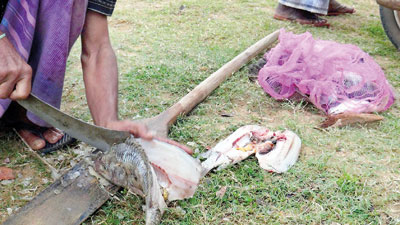
An unscrupulous man cuts up a dead fish which will soon be put on sale
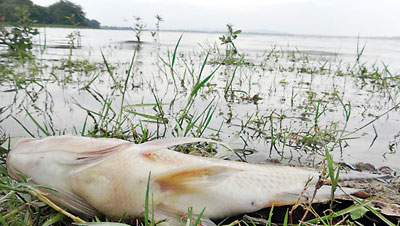
Unscrupulous traders may land this large dead fish which was washed ashore in your cooking pot or mine

Beware, hunters have taken to poisoning animals whose flesh they later sell to unsuspecting buyers
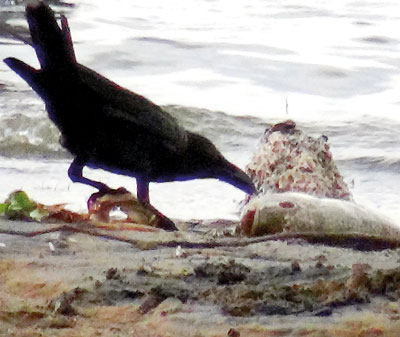
A crow attacking a tasty morsel
Source – 20/08/2017, The Sunday times, See more at – http://www.sundaytimes.lk/170820/news/making-a-killing-with-poisoned-food-255438.html

Fishing boats in the regulatory net for plastic waste
Thousands of fishing vessels that carry plastic water bottles and containers will be required to bring them back to shore under new laws being pondered to cut down the plastic waste piles that litter the oceans around Sri Lanka and choke precious marine life.
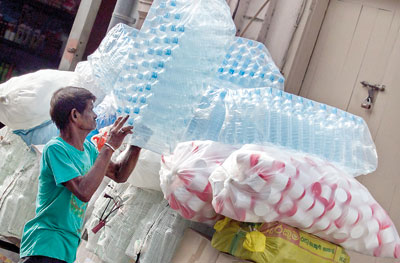
Sri Lanka among top marine polluters
When fishing vessels return to port, crews will be required to account for plastic containers they took on board. There are an estimated 53,900 fishing vessels in the dozen main fishing districts. The industry will be encouraged to use larger — five litres or more — water containers.
The Ministry of Fisheries and Aquatic Resources has joined hands with Marine Environment Protection Authority to bring in these measures.
Director General Christie Fernando said that all fishing vessels will have to account for the number of bottles of water. Boats will only be allowed to have on board containers of five-litre capacity or more and each vessel will be asked to report the number of bottles they have and account for the same on their return.
Fernando said that about 4,000 multi-day vessels cary about 100,00 litres of water to last a month. “They use the water for washing, cleaning, cooking purposes.’’
Fernando said a circular has been sent to all the district fisheries offices and to assistant fisheries directors. The regulation is being drafted and will be incorporated in the act soon, he said.
The Marine Environment Protection Authority said 22 fishing harbours will be monitored together with the Fisheries Ministry.
Chairman Rohana Perera said awareness of plastic waste will be raised. “We are encouraging them to manage, minimise and re-use plastic responsibly.’’
Source – 20/08/2017, The Sunday Times, See more at – http://www.sundaytimes.lk/170820/news/fishing-boats-in-the-regulatory-net-for-plastic-waste-255471.html

Desperate national parks battle poachers, curtail safaris and campers
National wildlife parks are struggling with an increase in poaching and are limiting access to safari operators and campers amid a devastating drought.
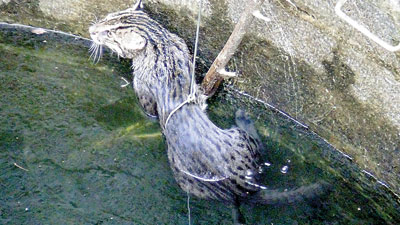 A fishing cat (handun diviya) was rescued last morning when the desperate animal in search of water had fallen into a well in Digampathana, Dambulla . Pic by K. Kanchana Kumara Ariyadasa
A fishing cat (handun diviya) was rescued last morning when the desperate animal in search of water had fallen into a well in Digampathana, Dambulla . Pic by K. Kanchana Kumara AriyadasaThe Yala National Park may even be closed to visitors next month.
There have been reports of animals poisoned at watering holes by poachers at various national parks.
Despite the drought, wildlife officials also say they will provide water only if necessary and instead allow nature to take its course.
Safari jeep operators are complaining of restrictions imposed on them.
The director general of the Department of wildlife Conservation, M G C Sooriyabandara said, park wardens are given the discretion to manage the situation and reduce safari vehicles entering the parks. “Even a one way system has been devised to reduce the same vehicles running up and down,” he said.
He said that the Yala National Park will be closed in September.
Mr Sooriybandara said that officials will rarely intervene in nature and will provide water only if it necessary.
“When we provide water, we choose tanks and watering holes near the safari trails regularly visited by tourists to attract animals, and to make sure that the regularly monitored area is secure from poachers.’’
He said joint patrols are undertaken against wildlife poachers. Wildlife range offices near national parks provide two officials from each office to combine with park rangers and form teams of 10 to carry out raids.
Meanwhile, park rangers and wardens have prepared their own plans.
The warden of the Wilpattu National Park, Chamath Lakshman Perera, said only 30 safari jeeps are allowed at a time, between 6:00 am and 10:00 and then from 2 p.m. to 6 p.m.Mr Perera added that both bungalows and campsites have been closed.
He said 28 small water tanks are being filled up using tanker trucks.
“Lots of poaching activities are happening during the dry months, so we reduce the safari jeeps,’’ he said.
Recently, they detected 13 trap guns and captured four armed men.
A wildlife official said the Yala National Park will be closed next month and will be re-opened after October.
Buddika Widanage, warden at Gal Oya National Park, said it was not badly affected by the drought thanks to the Senanayaka Samudraya. But he said the water levels in the reservoir had dropped.
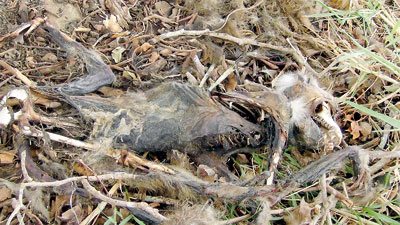
Thabbowa sanctuary: Fast turning into a graveyard for wild animals. Pic by Hiran Priyankara
He said park rangers and officials of the nearby wildlife offices carry out night patrols to catch poachers who set up trap guns or leave poisoned food at watering holes.
Mr Widanage also said campers are only allowed if they bring their own water.
“Even the three-hour boat rides have been cut to two hours” he said.
The Minneriya Park has suffered from the drought since last year, warden Bhathiya Madugalle said. Elephants are the worst effected — less than 10 remain in the park. Animals have moved to Kandalama Park and Ritigala Eco Park.
Mr Mudalige said that there is also less elephant grass.
He explained that water and food are not provided to animals so that the natural balance is maintained and to allow for the survival of the fittest.
Meanwhile, the Independent Safari Jeep Drivers Association claims unfair treatment.
The head of the group, P D Keerthi, said most parks had reduced access. He claimed the operators could provide water and food for anim,als but wildlife officials and the minister would not allow it.
Mr Keerthi also said the one way drive system for safari jeeps could be dangerous in the event of an attack by elephants, when reversing is the only choice.
He complained that although they are regulated, VIPs are allowed roam in the parks day and night.
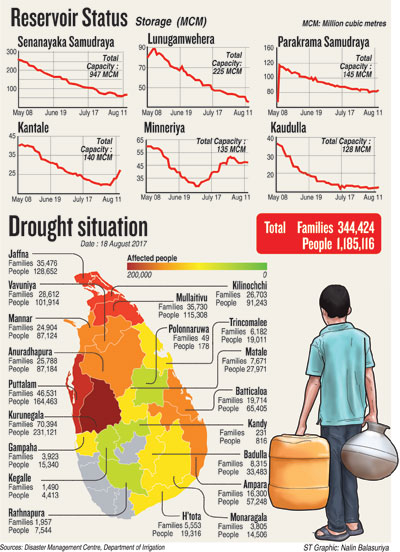
Source – 20/08/2017, The Sunday Times See more at – http://www.sundaytimes.lk/170820/news/desperate-national-parks-battle-poachers-curtail-safaris-and-campers-255478.html

The ‘Glen Falls’ at Nuwara Eliya is no more
The ‘Glen Falls’ which added much scenic beauty to Nuwara Eliya is drying up. The waterfall once synonymous with the town of Nu wara Eliya of which many a hotel and roads are named after is now visible only on rainy days. Area residents have watched as the waterfall dried up before their eyes.
wara Eliya of which many a hotel and roads are named after is now visible only on rainy days. Area residents have watched as the waterfall dried up before their eyes.
Colonial Governor Edward Barnes who designed and developed the town of Nuwara Eliya, set up his official residence in the vicinity of the magnificent 60 -70 metre high falls.
Today this beautiful waterfall is no more.
Despite the waterfall reappearing mainly during the monsoon season, this unfolding disaster does not seem to have attracted the attention of either the populace or those in positions of trust and authority.
Environmentalists claim the over utilisation of this precious water resource for the fast expanding commercial purposes as well as public sanitation, paved the way for the drying up of this once beautiful landmark.
They add potato cultivation on hill tops which commenced in the sixties also contributed to the drying up of the falls whose source spring is situated close to Shanthipura Kala Oya on the ‘Single Tree Mountain Range’ around 6,830 ft above sea level.
The then town of Nuwara Eliya 12.43 sq km in extent, was carved out by the British in 1828 and was originally a town of farmers with one Samuel Baker opening a 1,000-acre farm in 1848.
According to the census of 1881 ordered by then Government Agent (GA) Baros, the town was home to a population of 1,701 persons comprising 270 families.
Today the population consists of 35,000 persons, comprises around 7,500 houses, 3530 commercial buildings and 803 government buildings.
During the dry season water to the city is severely restricted as the sources for drinking water and sanitation needs remain the same as in 1881, other than the few deep-water wells provided via Japan’s JAICA.
The spurt in hotel construction will further stretch the scarce water resources in the area and will undoubtedly aggravate the situation.
If the situation is not tackled with sensitivity even the future existence of the city of Nuwara Eliya remains at risk.

Source – 20/08/2017,The Sunday Times, See more at – http://www.sundaytimes.lk/170820/news/the-glen-falls-at-nuwara-eliya-is-no-more-255450.html

